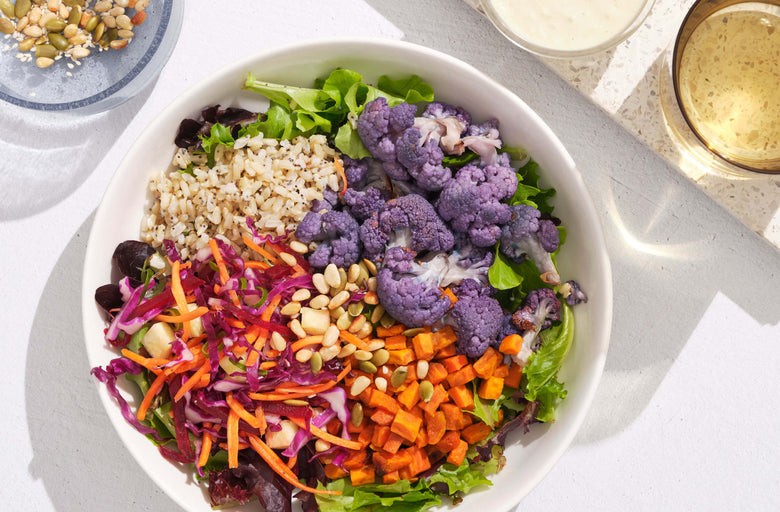Today’s modus operandi is go, go, go. It’s all about glorifying the busy. Even in a global pandemic, the internet is ablaze with ways to maximize your home-bound hours. In Traditional Chinese Medicine, this would be described as striving, action-oriented, yang energy. The beverage that embodies this energy best? Coffee. Many mark it as the sacred, sensual ritual that gets them up and out, but it’s hotly debated in the wellness world. It leaves Sakara clients curious about how coffee fits into their lifestyle—or if it should at all.
Let’s first get this out in the open: we love coffee too. The intoxicating aroma, the morning practice of pouring a mug and languidly sipping as you map out the day. Deciding whether or not coffee fits into your healthy lifestyle is something only you can do for yourself, by listening to your body. This is an excellent opportunity to employ body intelligence, or the art of fostering an intimate internal dialogue about your body and its needs. If you’re a devout coffee drinker, take a moment to check in with your systems. Be conscious of how you feel before, during, and after your morning brew. Take notes as you keep track for a few days, and assess. Is coffee bringing you joy, or is it a default habit? Does it bring you real bliss, or are you gripping onto the practice for fear that your energy can’t keep up with demands? These are important questions that will help you determine if the morning cup is serving you.
Recall that aforementioned yang energy? It’s worth noting that TCM contends it’s a decidedly male energy. And while men can thrive on coffee without consequence due to their 24-hour hormone cycle, women can potentially have physiological barriers to enjoying caffeine. The gene responsible for metabolizing caffeine is called CYP1A2. It’s the same gene that metabolizes estrogen, and it makes an enzyme to break down caffeine efficiently in the liver. Those who have a variant to the gene—you can do an at-home genetic test if you’re curious, but research shows about half of the population is included—are known as “slow metabolizers.” Because their livers spend a lot more resources and energy excreting the caffeine, they can experience adverse effects, most notably a jittery, anxious, wired feeling, or running off to the bathroom with the quickness. That wired feeling is inflammation, mixed with a spike in cortisol and insulin, which can last up to 24 hours. This upsets deep REM sleep, and inevitably you’re left reaching for coffee the next day, out of necessity, repeating a pattern that is tough on the body. While men are led by a 24-hour hormone cycle, women have a four-part, 28-day cycle. Going off-kilter by a couple of days can impede the month’s hormonal rhythm. Plus, if you experience hormone-related issues like fibroids, PMS, PCOS, or Endometriosis, your liver is doing double duty by straining to metabolize the coffee and estrogen with the same enzyme that isn’t extraordinarily efficient.
The science of caffeine’s inner workings aside, we don’t vilify foods, nor do we have a “never-touch-this-to-my-lips” list. Fear and guilt are more toxic than anything on your plate (or in your mug). We turn our focus, instead, to moderation, and an unyielding lust for the best in quality. Coffee’s many touted health benefits— namely, that it’s neuroprotective and rich with antioxidants—comes into play when you reach for small-batch, biodynamic, organic beans. A commitment to choosing organic is especially important here, as coffee is one of the most pesticide and chemically-laden crops. Try to purchase whole beans from a single, which stay fresh longer, retain their nutrients, and are less susceptible to mycotoxins.
Then when it’s time to sit down and savor, aim to drink your coffee mindfully. Avoid using it to overcompensate for a wildly overbooked schedule or a restless night of sleep—both scenarios in which a hit of caffeine is not doing your body many favors. Below, we offer three ways to partake in a coffee ritual, with only one recipe involving coffee at all. Embrace all the ceremony of your morning cup plus a few delicious ingredients that you may discover to be a welcome departure from the run-of-the-mill drip.

THREE WAYS TO REIMAGINE “COFFEE”
Naked:
- 1 cup of high-quality coffee (we like Canyon Coffee)
- Pair with: Nootropic Chocolates & a glass of water with Beauty Water Drops
Why this works: On its own, coffee can potentially disrupt the hormonal cascade and irritate the stomach lining. Most other cultures with a coffee practice drink after a meal, as a digestif to help break down fats and stimulate stomach acids. Even if you don’t change around when you partake, adding functional foods will create heightened, sustained energy without stripping your body’s resources to get you there. Nootropic Chocolates include a blend of hormone-regulating adaptogens plus an important caffeine ally: L-theanine. This amino acid activates alpha brain waves, which are the frequencies turned on during meditation and deep relaxation. L-theanine and caffeine don’t cancel each other out but instead create a hyper-focused elixir that soothes caffeine-related anxiety while piquing alertness. It’s a taxing job for the body to metabolize caffeine, and the liver must recruit many micronutrients, like magnesium and potassium, to help excrete it. Counteract the extra work your body must perform when you drink coffee by chasing it with a tall glass of water enhanced by Beauty Water Drops. The blend of 72 ionic minerals will flood the body with what it craves while you answer your soul craving.
Awakened Elixir:
- 1 cup of high-quality coffee or Dandy Blend Herbal Beverage
- ½ teaspoon Maca powder
- ½ teaspoon Reishi powder
- 1 spoonful coconut oil
- A generous splash of Green Milk
Why this works: Begin with a cup of organic coffee, or, if you choose to wean yourself off coffee but lust after the flavor, try Dandy Blend as a nice alternative (its ground-up dandelion and chicory root give off that distinct coffee flavor). Then, uplevel the morning brew with libido-boosting maca root and reishi mushroom powder. Reishi is medicinal mycelium, and once an important piece of the Egyptian pharaohs' diet for immortality. More recently, it’s been heavily researched for its anti-cancer properties and its support for the spleen, kidney, and liver (critical detox organs that could use some focused care if you’ve been a buzz hound). This recipe is further supercharged with a scoop of coconut oil, offering essential fatty acids that will help soothe the adrenals, cortisol, and insulin. The final flourish is unexpected but incredibly nutritive; founder and co-CEO of Sakara, Danielle Duboise, suggests mixing chlorella powder and almond milk into a pastel green mylk that tastes delicious when added to coffee and a healthy fat. You can put the ingredients in a blender and whip for optimum frothiness before returning the contents to a mug that requires two hands.
Revved-Up London Fog:
- 2 sachets of Earl Grey Tea or Sakara Detox Tea
- Steamed plant-based milk and hot water
- 1 scoop Metabolism Super Powder
- ½ Medjool date
Why this works: For days when you want to ditch coffee, there are still ways to brew a morning concoction that entices you out of bed. This recipe comes straight from a Sakara employee who is firmly planted in the no-coffee category, but loves a morning delight. Steep Earl Grey or Detox Tea in hot water, then add steamed milk, ½ a date, and a scoop of Metabolism Super Powder in a blender. The result is a spirited London Fog with a cacao twist and metabolism-boosting benefits.
Think Beyond the Morning Cup:
The Life-Changing Power of Herbal Infusions






